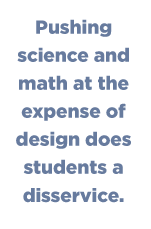LAST WORD: Bury the Cold War Curriculum
BY DAVID E. GOLDBERG
U.S. educators should instead stress qualitative thinking skills.
The engineering curriculum is broken, and despite action by the National Academy of Engineering and National Science Foundation, repair efforts are scattered, misdirected or ineffective. Prescriptions to date focus more on teaching methods than on correcting errors in content. Conventional wisdom says experiential learning can cure what ails the curriculum, and injection of real-world design experiences can cover curricular shortcomings. But experiential learning works best with small groups, not large student bodies. It also gives short shrift to lectures, which, when done well, can both inspire and inform.
A key problem is being overlooked, and that is the persistence of a Cold War curriculum in an Internet world. Pushing science and math at the expense of design may have worked once but is now doing students a disservice. Routine calculation can be outsourced to Shanghai and Bangalore. The global economy places a premium on more creative engineering activities at home. Furthermore, the death march of math and science disillusions some otherwise able students, causing them to drop out. Disproportionate numbers of the departing are minorities and women, whom engineering schools should instead be attracting. Moreover, students who come to engineering to be entrepreneurial, socially responsible or both wonder why business and ethics are merely bolt-on topics. When design is finally taught, students are unable to solve other than rote problems and struggle to communicate their results.
What today’s graduates need, and aren’t getting, are the skills that enable them to create the new categories of products demanded by 21st-century companies. Chief among these skills is qualitative thinking, or QualT, a concept that encompasses analytical ability, creativity and communication. Consider the inadequacies of students in an industrial capstone design course or engineering graduates on their first real design project. They approach their first client interview without the questioning skills needed to probe the problem. After coaching, they survive the trip to the plant but are then unable to model the problem qualitatively in words or diagrams. After finding that plugging into equations or codes doesn’t work, they are coached to build qualitative causal models of system operation. Thereafter they have difficulty decomposing the design, reasoning qualitatively about solutions and presenting results.
This list of shortcomings suggests that the common denominator to curing what ails the engineering curriculum is to better teach qualitative thinking across the curriculum, or QualTAC. Students trained in QualT skills are better able to approach their first real-world design experiences. QualT makes students less likely to bail out, and QualT gives women and minorities more reasons to stay. QualT skills are those needed by students who interface with markets, cultures and society, and QualT is the bedrock of all communication.
Before some accuse me of devaluing math and science, let me say that both remain important. However, excellent quantitative understanding needs to be built on better foundations of the qualitative. Even Newton moved from qualitative thinking about cosmology to quantitative solutions in the invention of physics and calculus. Moreover, before thinking QualT lacks rigor, consider its roots in philosophy. Those who believe philosophy is soft haven’t spent enough time with Plato, Kant or Searle.
Once QualTAC is recognized as a way out of our curriculum conundrum, the steps needed are clear. Start with qualitative exposure to engineering practice, processes and technology. Connect QualT in engineering with that in ethics, business, humanities, social sciences and the arts. Cross the qual-quant divide by starting with notions of quantity, measurement and dimensional analysis, moving on to other quantitative models in increasing-complexity order. As such, placing QualT at the center of 21st-century engineering becomes the guiding principle of curriculum reform.
Engineering graduates who can question, model, reason and communicate right out of the box depend upon our thoughtful action. Now.
David E. Goldberg is Jerry S. Dobrovolny Distinguished Professor in Entrepreneurial Engineering in the Department of Industrial and Enterprise Systems Engineering at the University of Illinois at Urbana-Champaign.
Category: Features
